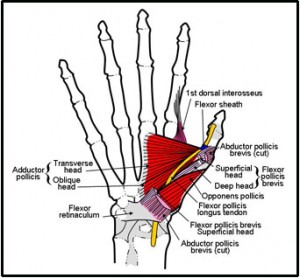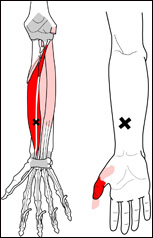The thumb is used in virtually all activities that involve the arm and hand. The thumb muscles, both the short ones in the hand (intrinsic) and the long ones (extrinsic) that control movement from the forearm are an important source of pain. Activities like texting on cell phones with buttons or emailing on Blackberries cause overuse of those muscles.
 The ones that are used with texting and Blackberries are the ones that flex the thumb, or bend the tip of the thumb inward toward the palm. The long flexor in the forearm bends the end joint of the thumb first, next the middle joint, third the joint at the base of the thumb and finally the wrist itself. The short flexors are in two layers both of which attach from the middle joint of the thumb to the middle of the wrist where it meets the bones of the fingers. They assist the long flexor in moving that joint toward the wrist.
The ones that are used with texting and Blackberries are the ones that flex the thumb, or bend the tip of the thumb inward toward the palm. The long flexor in the forearm bends the end joint of the thumb first, next the middle joint, third the joint at the base of the thumb and finally the wrist itself. The short flexors are in two layers both of which attach from the middle joint of the thumb to the middle of the wrist where it meets the bones of the fingers. They assist the long flexor in moving that joint toward the wrist.
The muscles which bring the thumb across toward the opposite side of the palm are the two parts of the adductor pollicis brevis that attach the middle joint of the thumb to the bone of the middle finger in the palm.
 The long flexor of the thumb (flexor pollicis longus) refers pain from its Trigger Point right into the thumb itself and as with the finger flexors, it can feel as if it’s going out the tip of the thumb. Dysfunction in the muscle itself can cause local tension and pain in the forearm where it is located.
The long flexor of the thumb (flexor pollicis longus) refers pain from its Trigger Point right into the thumb itself and as with the finger flexors, it can feel as if it’s going out the tip of the thumb. Dysfunction in the muscle itself can cause local tension and pain in the forearm where it is located.
The short flexors refer pain more into the base of the thumb and the fleshy part called the thenar eminence. Compression of the long flexor tendon between the layers can cause “trigger thumb” or “locking thumb.”
The muscle that brings the thumb toward the index finger is called the aDductor pollicis. It crosses the space between the index finger and thumb along with the 1st dorsal interosseous. The illustration shows it’s attachment to the bone of the middle finger in your palm (metacarpal). The aBductor pollicis brings the thumb away from it. The opponens pollicis brings it toward the pinkie and attaches the long bone of the thumb (metacarpal) to the wrist. All of these muscles have Trigger Points that refer into the thumb and base of the thumb.
 On the back side of the forearm above the wrist are the other extrinsic thumb muscles. These are directly related to deQuervain’s syndrome and cause pain in the radial side of the wrist near the base of the thumb, along the radius bone and just above it.
On the back side of the forearm above the wrist are the other extrinsic thumb muscles. These are directly related to deQuervain’s syndrome and cause pain in the radial side of the wrist near the base of the thumb, along the radius bone and just above it.
Analyzing the movements of the thumbs in everyday activities as well as in technology, being specific about which muscles are being overused, and networking that information with the pain patterns experienced, together shed light on how I target treatment for arm and hand pain in my Neuromuscular Therapy center near Boston.